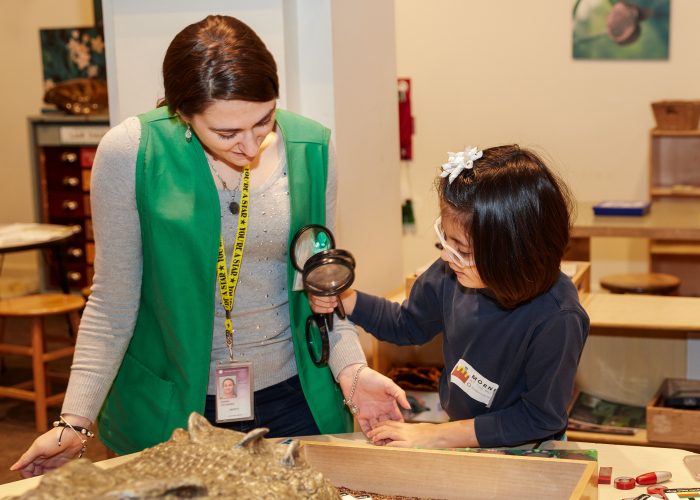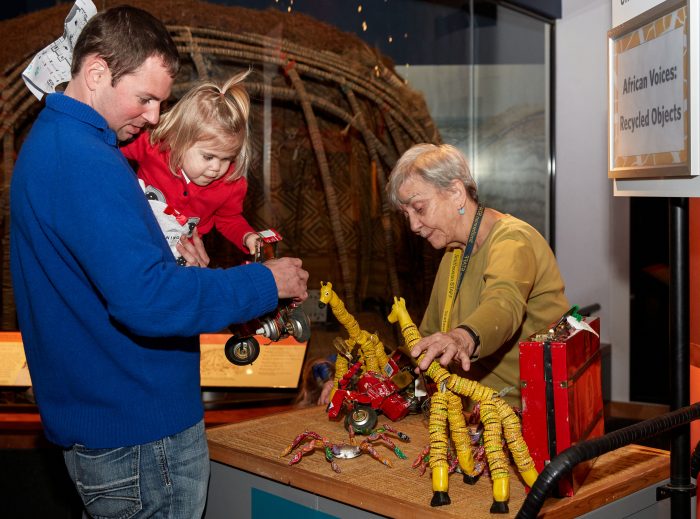Morning at the Museum
Morning at the Museum is a special program designed to help children with cognitive or sensory processing disabilities enjoy a visit to Smithsonian museums. A project of the Smithsonian Accessibility Program, Morning at the Museum has inspired similar programs at the U.S. Botanical Garden, the U.S. Capitol. The Kennedy Center and the International Spy Museum. Max Kibblewhite takes a look at the program’s origins and its approach to making the Smithsonian a welcoming experience for visitors of all abilities.
2017 brings about the triumphant return of Morning at the Museum to the Natural Museum of Natural History. Plagued by snow and sleet in years past, the program was welcomed back under Henry’s rotunda with open arms. In some cases, literally.

Morning at the Museum, a project of the Smithsonian Institution’s Accessibility Program and the Smithsonian Museums, invites visitors with cognitive and sensory disabilities to the Smithsonian Institution museums one hour prior to the official open hour so that participants can take advantage of the quiet and calm museum environment. Here, visitors engage in some early-morning yoga. (Photo by Jaclyn Nash)
Let’s take a look back at the history of Mornings at the Museum and all the steps and strides and rolls the program has taken to get to where we are today.
In 2009, director Beth Ziebarth and Krista Flores of the Smithsonian Accessibility Program began to realize that they were receiving more and more inquiries from the families of autistic children about the accessibility of Smithsonian museums. They formed a Community Advisory Committee comprised of museum educators, exhibit designers, professionals who work with children with cognitive or sensory processing disabilities, parents and self-advocates to research what accommodations the Smithsonian had to offer to for children with autism and their families. Unfortunately, they discovered there weren’t that many at the time.
The Advisory Committee partnered with the University of Maryland to develop a program specifically for children with autism and their families. Their research identified several key components that would be critical to a successful program:
First was avoiding overstimulation. If the program took place before regular museum hours, families could avoid long lines and crowds and be better able to determine which galleries might be too loud or too bright, thus allowing better control of the environment and avoiding overstimulation for kids with sensory processing disabilities. The program at the National Museum of Natural History, like many others, began at 9 a.m. and ran until 11 a.m.

Morning at the Museum, a project of the Smithsonian Institution’s Accessibility Program and the Smithsonian Museums, invites visitors with cognitive and sensory disabilities to the Smithsonian Institution museums one hour prior to the official open hour so that participants can take advantage of the quiet and calm museum environment. (Photo by Jaclyn Nash)
A second aspect was providing pre-visit materials to help families plan ahead. These materials include tools, strategies, stories, pictures—things that will help children and their families prepare for their visit.
“For example,” explains Ashley Grady, program specialist with the Smithsonian Accessibility Office, “We might create what’s known as a ‘social story,’ a strategy developed by educator Carol Gray that develops personalized text and illustration on a topic that ‘fits’ the specific audience. Research has shown those can be beneficial for a lot of diverse learners.

Morning at the Museum, a project of the Smithsonian Institution’s Accessibility Program and the Smithsonian Museums, invites visitors with cognitive and sensory disabilities to the Smithsonian Institution museums one hour prior to the official open hour so that participants can take advantage of the quiet and calm museum environment. (Photo by Jaclyn Nash)
“Another example is a visual or picture schedule that shows the actual places in a museum that families would visit, giving kids some ‘lead time’ so they know what to expect,” Grady continues. “Visitors also get a ‘passport’ that follows the picture schedule and allows visitors to collect a passport ‘stamp’ for each gallery they visit.”
Finally, the Committee realized it was very important to have a “take a break” space—an empty classroom or a quiet gallery where sensory materials such as koosh balls, big pillows and “stim toys” are available to help kids who need to work out some energy. Self-stimulatory behavior, also known as stimming, is the repetition of physical movements, sounds or repetitive movement of objects common in individuals with developmental disabilities, but most prevalent in people with autistic spectrum disorders.
After two years of research, a pilot program, Morning at the Museum, debuted at the American History Museum in April 2011. The Committee conducted extensive evaluation to determine what worked, what didn’t and how the program could best serve children and their families. Originally designed for children with autism aged 5 to 12, Morning at the Museum has expanded into more museums and evolved to meet the needs of different participants.

A young visitor enjoys a recent Morning at the Museum program at the National Museum of Natural History. (Photo by Jaclyn Nash)
“The program has grown and changed over time,” says Grady. “We have children with cognitive and physical disabilities, where stamina might be an issue. We have kids with sensory processing disorders. Our target population has expanded and the age range has expanded, too. A lot of our original participants in 2011 are growing up and we’re seeing a lot more teens and young adults.
“For example, at our last Morning at the Museum event at the National Portrait Gallery, we had a much larger percentage of teens—many of whom, we’ve learned, are interested in art. We’re really excited that the program can be so adaptable, because it’s meant for the whole family. Sometimes it can be hard for families who have a child with a disability to find activities everyone can enjoy together. We encourage siblings to come to Morning at the Museum so the whole family can enjoy the museum together.”
The Morning at the Museum Advisory Committee meets every month to work on keeping the experience fresh for repeat visitors and finding ways to expand the program into more museums. This year, the program has expanded to the Udvar-Hazy Center and the National Museum of the American Indian for the first time. The goal for 2017 is to introduce Morning at the Museum at the Hirshhorn Museum and Sculpture Garden and the National Museum of African American History and Culture.

The Morning at the Museum program allows visitors to avoid crowds by providing access before the museum opens. (Photo by Jaclyn Nash)
Each museum offers its own unique experience and the Morning at the Museum program is designed to reflect that. For example, the National Postal Museum isn’t usually too crowded and is a good environment for families, who frequently prolong their visit after the museum opens to the public. On the other hand, the Air and Space Museum is almost always busy and noisy, so having access to the museum before it opens is a boon to those who might not be able to tolerate the stimulation of regular visiting hours. The National Portrait Gallery offers yet another experience, with more controlled access to more limited galleries. The mission of the Accessibility Program Office is to find ways to make a visit to the Smithsonian a positive, meaningful experience for every visitor.
“I was a special education teacher for many years before I joined the Smithsonian,” Grady says. Everyone should have the opportunity to be in this amazing place. A former student of mine has a really hard time with anxiety and crowds. He uses noise-reducing headphones and has difficulty communicating verbally, but he loves artwork and he’s an excellent artist. He and his family came to one of our events at the National Portrait Gallery last fall. His mom called the office after the event to thank us, which was nice, but what was really wonderful was the call we got a few weeks later. He uses a communication device and when asked what he wanted for Christmas, he kept selecting the word “museum.” That was the best Christmas present any of us could have asked for—that he had such a positive experience he couldn’t wat to come back!”

A child wearing noise reduction headphones enjoys the aquarium during a recent Morning at the Museum program at the National Museum of Natural History. (Photo by Jaclyn Nash)
###
Posted: 17 February 2017
-
Categories:
Collaboration , Education, Access & Outreach , Feature Stories , Natural History Museum



